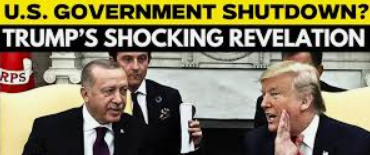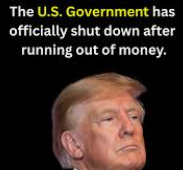News Discover the latest updates from Donald Trump’s government — including the shutdown crisis, immigration rulings, funding freezes, and political strategy inside the White House. A full human-written analysis of where America stands today.
America at a Crossroads News
News The United States is again standing at a political crossroads. President Donald Trump’s return to power has brought with it bold promises, dramatic decisions, and a storm of controversy that has once again divided the nation.
In the past few weeks, his administration has faced a government shutdown, major court battles, and funding freezes affecting millions of Americans. Supporters call it “tough leadership”; critics see it as chaos with real-world consequences.
What’s clear is that Washington has rarely been this tense — and the actions of the Trump government are shaping not only America’s present but its political future.
The Government Shutdown: A Fight for Power
On October 1, 2025, the U.S. government officially shut down after lawmakers failed to agree on a new federal budget.
Essential services — from national parks to research labs — began to slow or stop, while federal workers faced furloughs.
President Trump has framed the standoff as a battle against “wasteful spending” and “partisan obstruction.” He insists the administration must cut bureaucracy and focus on national security, border control, and energy independence.
However, Democrats and even some Republicans accuse the White House of using the shutdown as a weapon. By freezing funds to key programs — especially in states led by Democrats — critics claim the administration is pressuring Congress through the pain of ordinary Americans.
Economists warn that every week of shutdown costs billions in lost productivity and shakes global confidence in U.S. governance. Yet for Trump’s loyalists, the shutdown is proof of his willingness to fight the system rather than compromise.
Federal Funding Freezes and Political Pressure news

One of the most controversial moves by the Trump government in recent weeks has been the freezing of federal grants to several cities and states — including New York, California, and Illinois.
Officials say the freeze was necessary to audit “misuse of federal funds,” but critics argue it’s a form of political punishment aimed at Democratic strongholds.
New York was set to lose nearly $187 million in Homeland Security grants, which support counter-terrorism and emergency response. After bipartisan outrage, the White House reversed the decision — but only after days of public pressure and lawsuits.
This pattern — cut, then backtrack — has become familiar. The administration often announces aggressive changes, faces public backlash, and then partially walks them back. The strategy keeps the political spotlight firmly on Trump, who thrives on the image of a leader under siege but unbending.
Immigration Policy: The Legal Battlefield news

Immigration remains one of the most defining issues of Trump’s presidency.
In September and early October, federal courts issued two major rulings that shook the immigration debate once again.
- Birthright Citizenship Challenge:
The Trump administration had tried to limit citizenship for children born in the U.S. to non-citizen parents — a move widely seen as unconstitutional. Federal courts blocked the policy, reaffirming the 14th Amendment’s guarantee that anyone born on U.S. soil is a citizen. - Temporary Protected Status (TPS) Rollback:
In contrast, the Supreme Court allowed the government to end TPS protections for thousands of Venezuelan nationals who had fled political turmoil at home. This means many long-time residents could lose their legal status within months.
Both decisions highlight the limits and power of executive authority. Trump’s team celebrates the TPS ruling as a “win for law and order,” while civil-rights groups hail the birthright citizenship ruling as a victory for the Constitution.
The mixed outcomes show that the courts — not Congress — are currently defining immigration policy in the Trump era.
The Supreme Court: A Decider in Chief news
The U.S. Supreme Court has become a central player in the Trump government’s story.
With a solid conservative majority, the Court is hearing a slate of cases that will determine how far a president can go in reshaping federal agencies and using executive orders.
Upcoming cases include:
- Limits of Presidential Power: Can a president remove independent officials at will?
- Trade and Tariffs: How much authority does the president have to impose tariffs without Congress?
- Election Oversight: What control can federal agencies have over state-run elections?
Legal scholars say this term could redefine the balance of power in Washington for decades. Trump’s allies hope the Court will reinforce a “unitary executive” vision, granting the president sweeping control over the bureaucracy.
Opponents warn that such rulings could erode the checks and balances that protect democracy itself.
Economic Effects: A Volatile Mix of Growth and Risk
While political battles dominate headlines, the economy under Trump 2.0 remains a mix of strength and uncertainty.
- Markets: Wall Street has shown resilience, with tech and defense stocks rising on deregulation and military spending. But volatility spikes whenever shutdown news hits.
- Inflation and Jobs: Inflation has cooled compared to 2024 highs, but consumer prices remain sticky. Job growth slowed in September, partly due to government contractor layoffs.
- Global Trade: Trump’s renewed tariff threats on China and the European Union are worrying investors. Some economists fear a new trade war could disrupt supply chains just as inflation begins to ease.
The White House maintains that the economy is “stronger than ever,” pointing to energy exports, manufacturing upticks, and rising small-business optimism. Critics argue that short-term gains mask deeper structural weaknesses caused by policy instability.
Public Reactions: A Divided Nation
Across America, reactions to Trump’s policies remain as polarized as ever.
Supporters say:
- The president is standing up to “career politicians” and fighting for taxpayers.
- He’s restoring “law and order” and putting America first in trade and foreign policy.
- The media unfairly targets him while ignoring the corruption of Washington insiders.
Critics counter:
- His administration is chaotic and vindictive, using power to punish opponents.
- The funding freezes hurt citizens, not politicians.
- His rhetoric continues to divide communities and weaken America’s global reputation.
Polls show Trump maintaining strong support among his base — particularly rural and working-class voters — but struggling with moderates and suburban voters who want less confrontation and more stability.
Foreign Policy and the “America First” Revival
On the global stage, the Trump government is re-asserting its “America First” doctrine.
The U.S. has reduced funding to international organizations it deems “ineffective,” tightened immigration from unstable regions, and re-emphasized energy independence through expanded oil and gas drilling.
In foreign relations:
- Ukraine Aid: Trump has pushed for a “loan-based” approach to further aid, demanding repayment instead of grants.
- China: Tariffs and tech export controls are back, with new restrictions on AI chip sales to Chinese firms.
- Middle East: The U.S. has strengthened ties with Israel and Gulf nations while warning Iran of “serious consequences” for any nuclear escalation.
Diplomats say the policy is consistent — tough and transactional — but critics worry it isolates the U.S. from allies and undermines the multilateral system built over decades.
Inside the White House: Strategy and Survival
Sources close to the Trump administration describe a White House operating like a campaign headquarters more than a traditional government office.
Trump’s inner circle, including loyalists from his first term, focus on maintaining control over media narratives and energizing the base ahead of the 2026 midterm elections.
Key aides — like senior advisor Stephen Miller and Chief of Staff Mark Meadows Jr. — are shaping policies on immigration, digital censorship, and economic nationalism.
The communications team emphasizes direct outreach through X (formerly Twitter) and Truth Social, bypassing mainstream media entirely.
“Every move is about optics and message discipline,” one former official told reporters. “Trump wants to show he’s fighting for the people, even if it means breaking the rules of Washington.”
Legal Storm Clouds
Even as Trump governs, he remains entangled in multiple legal investigations.
Several state-level cases related to his businesses, taxes, and actions during his first term are still pending.
While none have stopped him from holding office, they continue to generate headlines and shape public perception.
Trump dismisses all legal challenges as “political witch hunts.” Yet the legal costs and court appearances highlight the extraordinary reality of an American president simultaneously governing and defending himself in court.
What’s Next: Key Dates to Watch
- October 15 – 20: Congress may vote on a short-term funding bill to end the shutdown.
- November 2025: Supreme Court hearings begin on presidential removal powers.
- December 2025: Deadline for states to submit immigration enforcement compliance reports — a flashpoint for new lawsuits.
- January 2026: Potential re-opening of comprehensive budget talks ahead of the next fiscal year.
Each date could shift the national conversation dramatically.
The Bigger Picture
The Trump government’s second term is rewriting the playbook of modern American politics.
It blends populism, nationalism, and unapologetic executive action — a style that inspires loyalty among millions and alarm among millions more.
For supporters, Trump is finally dismantling the “deep state” and delivering promises made years ago.
For critics, he’s testing the limits of democracy and straining the Constitution’s safeguards.
What cannot be denied is that Trump has again placed himself — and America — at the center of the global stage. Whether this era will be remembered as one of renewal or decline depends on how the next months unfold.
Complete Guide to Insurance in the USA: Comparing Different Policies and Choosing the Best
